Table of Contents
Lightning Protection Guide
COPYRIGHT & TRADEMARKS
Specifications are subject to change without notice. 
 is a registered trademark of TP-Link Systems Inc. Other brands and product names are trademarks or registered trademarks of their respective holders.
is a registered trademark of TP-Link Systems Inc. Other brands and product names are trademarks or registered trademarks of their respective holders.
No part of the specifications may be reproduced in any form or by any means or used to make any derivative such as translation, transformation, or adaptation without permission from TP-Link Systems Inc. Copyright © 2025 TP-Link Systems Inc. All rights reserved.
http://www.tp-link.com
Intended Readers
This guide is intended for network engineers and network administrators.
Conventions
When using this guide, please note that the figures are used for demonstration only.
The information in this document is subject to change without notice. Every effort has been made in the preparation of this document to ensure the accuracy of the contents, but all statements, information, and recommendations in this document do not constitute a warranty of any kind, expressed or implied. Users must take full responsibility for their application of any products
1. Introduction
Lightning is a violent discharge phenomenon that occurs in the Earth's atmosphere and can cause severe natural disasters. With the advancement of science and technology, a larger communication network has been built by computers, various networks, and communication devices. As the network scale expands, the threat of lightning to network equipment becomes increasingly prominent. It not only causes direct damage to devices but can also lead to the interruption of the entire network system, resulting in incalculable economic losses. Therefore, it is necessary to understand lightning and correctly install and use network equipment.
This manual will introduce the basic knowledge of lightning protection for rack-mounting installation of TP-Link network products, including the overall principles, methods, and precautions of lightning protection, and provide detailed explanations on lightning protection measures such as proper cabling, correct grounding, equipotential bonding, and the use of lightning arresters.
1.1 Scope of Application
This manual applies to the following products: TP-Link rack-mount devices.
This manual is for technicians who install, use, and maintain the above products.
1.2 Conventions
This manual uses the following formats to highlight special messages:
Warning: This is to remind you to be careful; otherwise, the device may not be in a protected state, resulting in device damage or malfunction.
Note: This is to provide supplementary information.
1.3 Overview
Chapter 1: Introduction to the manual.
Chapter 2: Overview of lightning protection. This chapter will briefly describe the hazards of lightning and the basic principles of lightning protection.
Chapter 3: Proper cabling. This chapter will help you properly cable your devices for lightning protection.
Chapter 4: Grounding requirements. This chapter will briefly describe the grounding requirements and provide on-site grounding solutions.
Chapter 5: Equipotential bonding.
Chapter 6: Using lightning arresters.
1.4 Related Standards
This manual has referenced the following standards:
- IEC61643-21:2000 Surge protective devices connected to telecommunications and signalling networks – Performance requirements and testing methods
- ITU-T K.27 Bonding configurations and earthing inside a telecommunication building
- ITU-T K.35 Bonding configurations and earthing at remote electronic sites
- ITU-T K.46 Protection of telecommunication lines using metallic symmetric conductors against lightning-induced surges
- ITU-T K.66 Protection of customer premises from overvoltages
- IEC62305-1 Protection against lightning –Part 1: General principles
- IEC62305-2 Protection against lightning –Part 2: Risk management
- IEC62305-3 Protection against lightning –Part 3: Physical damage to structures and life hazard
- IEC62305-4 Protection against lightning – Part 4: Electrical and electronic systems within structures
- IEC 60364-5-54 Electrical installations of buildings – Part 5-54 Selection and erection of electrical equipment – Earthing arrangement, protective conductors and protective bonding conductors
2. Overview of Lightning Protection
This chapter will introduce the characteristics of lightning, explain the hazards of lightning strikes to network equipment, and propose the main principles of lightning protection.
2.1 Lightning Characteristics
Lightning carries immense power. The following facts offer a clear, intuitive understanding:
- Strong current and voltage: The current of ordinary lightning can reach tens of thousands or even hundreds of thousands of amperes, and the voltage can reach millions of volts. Such extreme current and voltage can instantly ionize the air, creating a conductive path for discharge;
- Huge energy release: It is estimated that the energy released by a lightning strike is about 500 million joules, equivalent to 14,000 kilowatt-hours of electricity, which can keep a 100-watt light bulb lit for about 160 years;
- Extremely high temperature: When lightning strikes, the temperature inside its channel can instantly rise to 30,000 degrees Celsius, which is more than five times the temperature of the sun's surface;
- Huge destructive power: Lightning can damage tall structures and generate powerful electrical noise, leading to equipment failure and widespread power outages.
Lightning has such tremendous power, while the operating voltage of electronic communication equipment is constantly decreasing with the number of devices is increasing, leading the equipment prone to damage from lightning strikes.
2.2 Types of Lightning Strikes
Lightning strikes have two types: direct lightning strikes and induced lightning.
2.2.1 Direct Lightning Strikes
Direct lightning strikes refer to the phenomenon where discharge occurs directly between clouds and protruding objects on the ground such as buildings or trees. As the immense current of lightning can directly enter the ground through these objects, lightning often causes severe damage to objects along the discharge path and even leads to personal injury or death.
If lightning directly strikes power lines or communication lines entering a building from outside, it will cause overvoltage and overcurrent at the equipment power supply or network interfaces, thereby damaging the equipment.
Ground potential rises may also result in equipment damage. A ground potential rise occurs when a direct lightning strike hits the building's lightning arrester (lightning rod or lightning protection net). This will cause a massive current to flow through the grounding system, generating a voltage difference across the grounding resistor. This voltage difference will be introduced into the equipment through the ground wire, causing damage.
2.2.2 Induced Lightning
Induced lightning refers to the phenomenon where discharges occur between clouds or between clouds and the nearby ground, causing overvoltage and overcurrent in conductors like power lines, communication lines, and metal pipes. Compared to direct lightning strikes, induced lightning has a higher probability of occurrence and is more widespread.
During a lightning discharge, the rapidly changing current induces a strong electromagnetic field in the surrounding space, causing induced overvoltage and overcurrent in power lines and communication lines, thereby damaging equipment.
2.3 How Lightning Damages Equipment
Lightning can damage equipment in the following ways:
- When a lightning arrester or its surrounding objects are struck by direct lightning through an air-termination system, the ground potential will increase, causing damage to the equipment.
- When the lightning current is led into the ground through the lightning down conductor, the rapid current changes generate strong electromagnetic fields. These electromagnetic pulses can couple into equipment wiring, potentially causing damage to the equipment.
- Direct or induced lightning strikes the far end of the power line and communication lines connected to the equipment, causing overvoltage and overcurrent to flow along the lines, damaging the equipment.
2.4 Equipment Lightning Protection Principles
There are two basic principles for equipment lightning protection. First, equipment lightning protection should be systematic, which means the equipment and its operating environment should be considered as a whole for lightning protection. Second, all lightning protection measures are "probabilistic"; that is, taking lightning protection measures cannot guarantee that the equipment is 100% safe, but it can reduce the risk of equipment failure or damage.
Therefore, both external and internal lightning protection measures are needed to fully safeguard the building's electronic information system, as shown in the following:
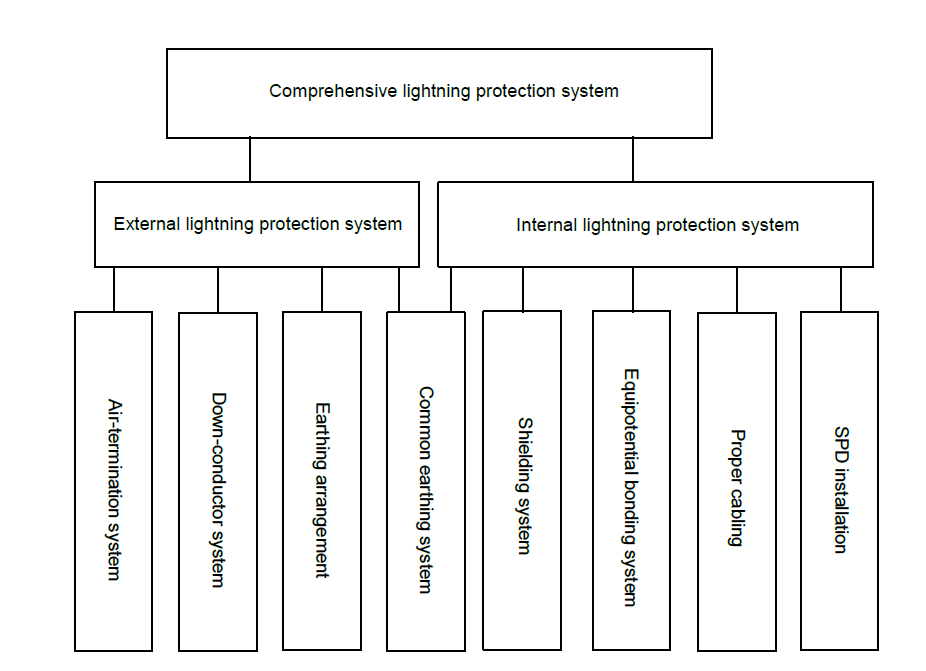
2.4.1 External Lightning Protection
External lightning protection measures, composed of air-termination system, down conductors system, and earthing arrangement, are mainly used to protect against direct lightning strikes.
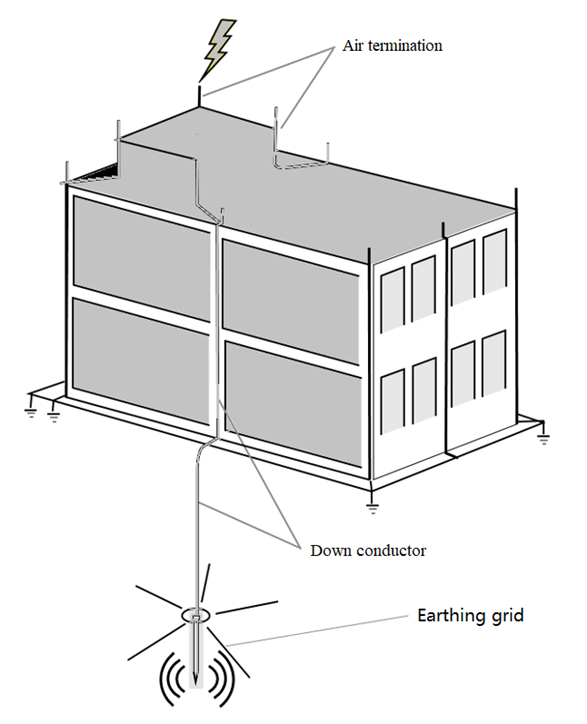
Air-termination system are usually located on top of buildings. Their principle is to use their protruding position above the protected objects to guide lightning to themselves and receive direct lightning discharges. Lightning currents enter the ground through the down conductors and earthing arrangement.
For TP-Link product users, if conditions permit, it is advised to install the equipment in a building with the above-mentioned external lightning protection measures, and have professional technicians regularly check the reliability of the building's lightning protection facilities. The lightning protection design of the building should comply with relevant national standards.
2.4.2 Internal Lightning Protection
Internal lightning protection measures, composed of common earthing system, shielding system, equipotential bonding system, proper cabling and SPD(lightning arrester) installation, are mainly used to reduce and prevent the electromagnetic effects of lightning currents to reduce device damage brought by lightning strikes.
When installing and cabling devices, users should pay special attention to the requirements of the above measures. The subsequent chapters of this manual will introduce the above measures in detail.
3. Proper Cabling
3.1 General Requirements for Cabling
Proper cabling of communication cables and power supply lines can effectively reduce the damage caused by induced lightning strikes. In an actual network environment, cabling may need to be done indoors or outdoors depending on the location of the network equipment. The requirements in these two cases have large differences.
Warning:
- Communication cables should be routed indoors, avoiding overhead routing or over-the-eaves routing to effectively reduce the damage of induced lightning strikes on equipment.
- If the device is installed indoors, the AC power line should not be directly introduced from outdoors to avoid damage caused by lightning strikes.
- Ethernet cables and power lines should not be routed close to each other or parallel to each other over long distances.
3.1.1 Outdoor Cabling Requirements
Under normal circumstances, avoid running cables outdoors. If it cannot be avoided, use optical-fiber cables as the communication cables. Since optical fibers usually do not have conductors (if there are metal reinforcement cores or other conductors in the optical cables, the conductors should be directly grounded at the entrance), they will not be struck by lightning and there is no need to install lightning arresters. Thus, the optical fibers can be used for overhead routing.
If cables have to be run outdoors, strictly comply with the following requirements:
- It is prohibited to run overhead cables between buildings without taking any protective measures, as shown in the figure below:
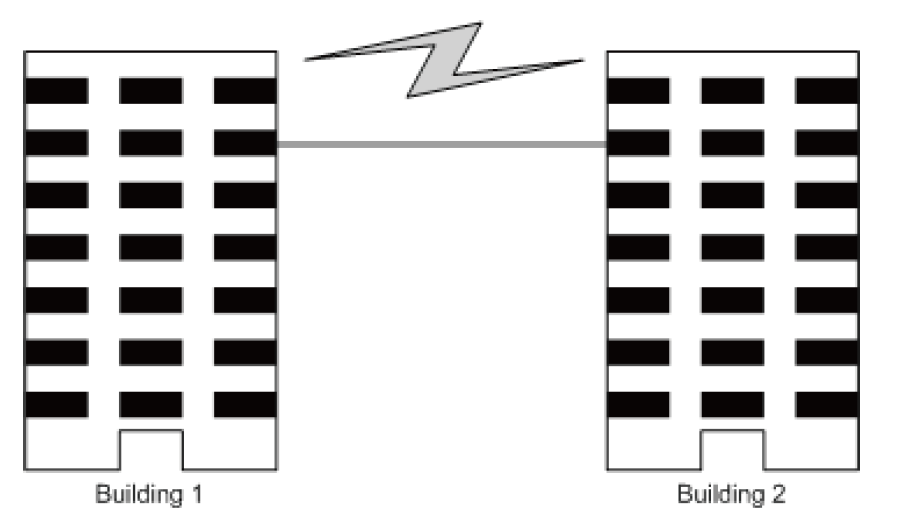
- It is prohibited to connect devices on different floors by wiring along the outer wall of the building, as shown in the following figure:
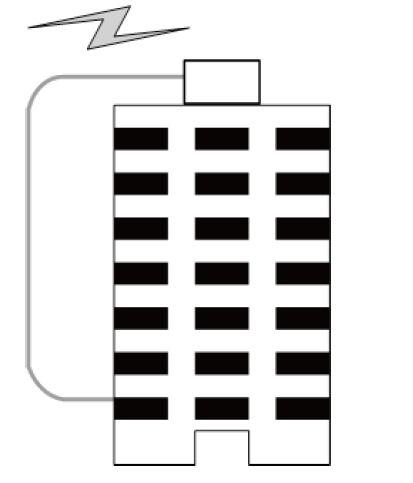
- If cables have to be run outdoors, it is advised to bury them all underground and bring them indoors from underground. It is recommended to bury a steel wire along the outside of a pipeline, with one end of the steel wire connected to the lightning protection ground of the building to provide shielding. Before connecting to devices, install a signal lightning arrester at the corresponding end.
- If cables have to be run overhead outdoors, it is advised that the cables pass through a metal pipe at least 15 meters long before entering the room, and both ends of the metal pipe should be grounded. Before connecting to devices, install a signal lightning arrester on the corresponding port.
- If fully shielded network cables are used, they do not need to be laid in the pipe. However, be sure to ground the shielding layer of the network cables reliably to ensure shielding. Before connecting to devices, install a signal lightning arrester on the corresponding port.
- When connecting outdoor wires without any protective measures to devices, be sure to install a power lightning arrester or a signal lightning arrester on the corresponding interface.
Note:
Lightning arrester is not provided with the product. Users need to prepare by themselves. For the installation guide of lightning arresters, refer to Chapter 6 of this manual.
3.1.2 Indoor Cabling Requirements
When cabling indoors, keep communication cables away from down conductors, power lines, transformers, motors, and other sources of high-frequency interference. Avoid bundling different cable types together.
- Trunk cables should be laid in metal raceways located in the electrical shaft of buildings. When laying cables, pay attention to reducing the loop area formed by the cables themselves.
- The distance between the Ethernet cables and other pipelines should meet the following requirements:
|
Other Pipelines |
Ethernet Cable |
|
|
Min. Parallel Net Length L (mm) |
Min. Parallel-overlapping Net Height H (mm) |
|
|
Down-conductor |
1000 |
300 |
|
PE |
50 |
20 |
|
Service pipe |
150 |
20 |
|
Compressed air pipe |
150 |
20 |
|
Thermal pipe (not wrapped) |
500 |
500 |
|
Thermal pipe (wrapped) |
300 |
300 |
|
Gas pipe |
300 |
20 |
The min. parallel net length (L) is the shortest distance between two or more cables laid in the same direction along parallel planes. The min. parallel-overlapping net height (H) is the shortest clearance between cables when cables from different directions intersect on the same plane.
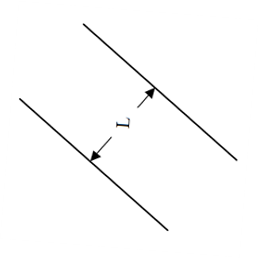
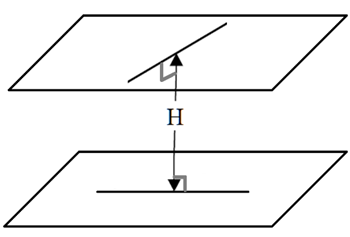
Fig. 2 Min. parallel net length (L) and min. parallel-overlapping net height (H)
Warning:
The above requirements are specific to the cables without metal raceways. If any requirements cannot be met, consider using steel pipes or metal raceways for shielding.
- The distance between communication cables and power lines of high-power electrical devices should meet the following requirements:
|
Cable |
Pave Way |
Min. Parallel Length |
|
>5kVA powerline |
Parallel cabling |
130 |
|
One is in the grounded metal raceway or metal pipe |
70 |
|
|
Both are in the grounded metal raceway or metal pipe |
10 |
|
|
|
Parallel cabling |
300 |
|
One is in the grounded metal raceway or metal pipe |
150 |
|
|
Both are in the grounded metal raceway or metal pipe |
80 |
|
|
>5kVA powerline |
Parallel cabling |
600 |
|
One is in the grounded metal raceway or metal pipe |
300 |
|
|
Both are in the grounded metal raceway or metal pipe |
150 |
- The distance between communication cables and high-power electrical devices should meet the following requirements:
|
Device |
Min. Distance |
|
Switch case |
1.00 |
|
Transformer room |
2.00 |
|
Elevator tower |
2.00 |
|
Air-conditioner room |
2.00 |